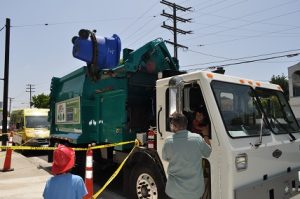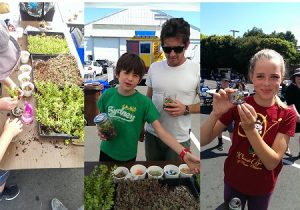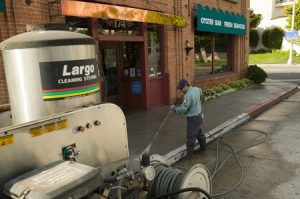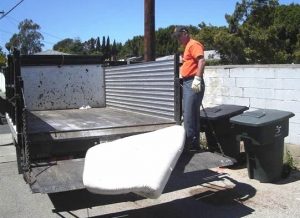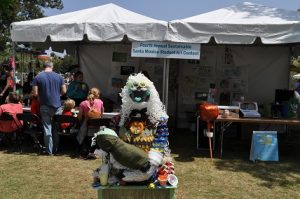Through consistently changing and upgrading their sustainability solutions, creating innovative community participation recycling events and growing their waste diversion rate, the City of Santa Monica has developed a visionary plan to strengthen their waste programs.
Since the early 1950s, the City of Santa Monica’s Sanitation Department has provided waste collection services for its residents. Currently, it is up to the city’s Resource Recovery and Recycling Division (RRR) to collect trash, recycling, organic waste, bulky items, public litter, public recycling as well as materials generated from special events. The RRR also operates the City’s street sweeping services and pressure washing services. With 116 employees and 78 vehicles, which are all alternatively fueled with CNG, hydrogen, electric and propane, the RRR exclusively services more than 90,000 residents and businesses within the city of Santa Monica. Seventy percent of all waste generated in Santa Monica is from multifamily residents.
The RRR handles numerous recyclable materials, including all plastics 1 through 7 (except 6). Polystyrene (otherwise known as styrofoam) has been banned from use in the city of Santa Monica since 2008. All businesses providing food for take-out must use a non-polystyrene container. In 2011, the city also passed the Single Use Plastic Bag ordinance which prohibits retailers from providing plastic bags for carry out of merchandise. In addition to the plastics, the RRR collects all types of metals, scrap metal, and glass (except window panes), as well as electronics, all grades of paper, cardboard, white goods, tires, used oil and textiles. The City has mandated that 70 percent of construction and demolition debris generated within Santa Monica be recycled. The City also monitors a contract for Curbside Household Hazardous Waste Collection for residents only.
Growth and Development
According to Kim Braun, the RRR Manager, Santa Monica experienced a slight growth in the economy this past year, which resulted in an increase in trash volumes. “New businesses are opening in the city and larger multifamily buildings are being constructed. Since Santa Monica is a beach town, tourism is up as well. This resulted in the addition of trash routes and recycling routes to our operation, which increased expenditures through labor, equipment, processing and disposal. As the volumes of trash continued to increase, we needed to address recycling and organics waste programs to continue to maintain our current 77 percent diversion record.” All new businesses in the City are required to have a waste container, a recycling container and an organics container if the business provides a food service. Through daily tonnage reports per route, the RRR staff identifies areas in the City with increased trash volumes and decreased recycling volumes. Once these areas are identified, the staff reaches out to businesses, multifamily property owners/managers and singlefamily residents to discuss recycling programs and organics waste programs.
Community Education
The RRR also keeps the community aware of waste, recycling and environmental issues through an extensive education program, which involves the mascot “Curby” and an outreach trailer with video games and educational materials to keep the local children engaged and learning. In addition, the RRR electronically sends a monthly newsletter to its residents, and has an active Facebook Page, Twitter, and Instagram accounts to assist in educating residents on all the various recycling and reuse programs that the City offers. Staff also participates in educational sessions at the Santa Monica Farmers Markets, neighborhood associations, Chamber of Commerce meetings, and conducts recycling and composting workshops at the local schools.
Shredding and Electronics
Monthly, the RRR hosts a community event that includes paper shredding, electronics recycling, compost give away, a city wide yard sale, the Halloween Costume Swap and the newest venture, the Repair Café. “The paper shredding event is our most popular event, with more than 500 residents taking advantage of shredding their secure documents. Along with the paper shredding event, residents can bring electronics such as cell phones, microwaves, televisions, monitors, vacuum cleaners and other products for recycling,” says Braun.
Yard Sale Sponsorship
In August of each year, the City sponsors a Yard Sale event to promote reuse. Residents sign up to participate as an active seller in the community. The City provides a map with all addresses that will be participating and the types of items for sale on the designated yard sale day. Some neighborhoods sponsor block parties during this event and rent out their very own Party Trash Truck. Kids, ages three and older, can sit in the party trash truck and operate the buttons that allow the gripper arm to pick up the trash and recycling containers and dump them. The feedback for both this event and the party truck is always positive and it is one of the RRR’s most successful programs.
Costume Swap
The RRR’s Halloween Costume Swap is in its second year. About one month prior to Halloween, old costumes are accepted at local libraries and the donors are provided with a costume swap voucher. This voucher entitles the family to come to one of the local libraries on a specific day to peruse other donated costumes and hopefully find a really cool one for Halloween. Staff can also assist with making costumes out of recycled materials and face painting is also available.
Repair Cafe
To further promote reuse, RRR started its own Repair Café. Volunteers, known as “Fixers”, will repair broken items that would otherwise be thrown away. Items that have been “fixed” at the last event included jewelry, bicycles, lamps, clothing that was torn or needed to be hemmed, cell phones, computers and even a knife sharpening volunteer. The last event generated more than 150 work order tickets for repairs. The City also promoted textile recycling and with the assistance of the contractor US Again, and residents built a mountain of clothing at the repair event.
Composting
Quarterly, to promote the RRR’s organics waste composting program, residents are provided free compost. Says Braun, “The RRR developed a wonderful video which teaches the residents what materials can go into the organics waste container and the entire composting process from collection through to compost give away day.” The RRR gives away two full 30-yard containers of compost at each event.
SWANA’s Gold Excellence Award
The RRR is very proud to have won SWANA’s Gold Excellence Award for Collections Systems in 2013. This award was achieved by applying a new software program to existing collection routes. “All of the collection vehicles are equipped with laptops and the drivers can communicate to dispatch advising if a container was collected, blocked, not out or contaminated,” explains Braun. “In addition, the routing program consolidated routes resulting in $1 million in savings. In preparing for the consolidation of routes, the RRR conducted a citywide container audit using modified duty staff, which resulted in Total Temporarily Disabled cost savings of $ 289,000. This modified duty program has grown citywide and city employees from other departments participate in the RRR’s program by auditing recycling and organics waste containers to determine participation rates and contamination levels. Accounts are identified for lack of participation and for large amounts of contamination. Staff can then reach out to the customer to assist in implementing a recycling and/or organics waste program or provide educational materials to reduce the contamination levels.”
Handling Daily Challenges
“We have challenges daily in our operations,” says Braun. “Santa Monica has implemented so many programs over the years, such as converting rear loader collections to automated and implementing organics waste collections.” In 1997, the RRR began operating a CNG station and converted all of its trash and recycling vehicles to operate only on CNG fuel. “Imagine finding manufacturers to convert trash vehicles to operate on CNG fuel as well as trying to find companies that could maintain and repair a fully operational CNG fueling station in 1997?” laughs Braun.
In 2010, the RRR began its routing software project and met challenges with staff learning how to properly use the tablets to provide big data, communications to residents when changing many of the collection days and updating software to meet current needs. In 2011, RRR added food waste and all compostable paper products to its existing yard waste collections program. Finding a composting facility to take not only yard waste, but also food and compostable waste mixed into these loads was difficult. Getting the residents to understand all materials that were accepted in the green organics cart was and still remains a challenge for the division.
For more than 20 years, the City operated its own Household Hazardous Waste Facility. Residents were permitted to bring HHW materials to the facility four days per week. In 2013, the City closed the HHW facility and began a curbside HHW collection program. This transition met with resistance from the residential community with the largest complaints stemming from the wait to schedule an appointment for the pickup. Most preferred being able to put the materials in their car and drive to the facility for drop off. “After several months of tweaking the collections system, the pick up is scheduled within a two week time period which has satisfied many of the residents participating in this program,” says Braun.
She also points out that the RRR’s biggest challenge has been maintaining the existing diversion rate. “Seventy percent of all waste generated in Santa Monica comes from the multifamily sector. Many of the buildings do not have space for any trash/recycling or organics containers. The buildings share containers with other businesses and multifamily dwellings. The containers are actually located and permanently remain in the alleys. The container sizes may vary from 95 gallons to 300 gallons and 1 yard to 4-yard bins. Many of the container types do not lock and can be used by anyone. This contributes to a high contamination level for our recycling and organics waste.” The RRR attempted to use lockable bins in the alleys but discovered that trash and recyclable materials were placed on the ground next to the bin when locked. This created an eyesore for the residents as well as additional clean up for the collections crews. “Our contracted recycling facility does separate materials on site however, there remains several routes that can maximize up to an 18 percent contamination rate on any given day. As part of our zero waste strategic plan, the City will eventually collect as a wet and dry system which will reduce the contamination levels,” says Braun.
She continues, “Right now, I think the biggest challenge to our industry is developing the technologies to process materials that cannot be reused or recycled. Producers of these materials need to develop final use alternative plans for their products other than disposal at landfills or waste to energy facilities.”
Higher Diversion Rates
Braun states that the RRR’s most outstanding achievement is reaching a 77 percent diversion rate. “Implementing recycling and organics waste programs was the low hanging fruit to help Santa Monica reach its 77 percent diversion rate,” says Braun. “More recently, we have developed a Zero Waste Strategic Plan with 95 percent diversion being our City’s target by the year 2030. This plan was adopted by our City Council in January 2014.” As part of the Zero Waste Strategic Plan, the RRR will be implementing every other week trash collection for its single-family residents and an organic waste collections program for its multifamily residents. The planning phases have begun with implementation of these programs expected in CY 2016. Now, the future remains with other programs such as textile recycling, proper processing of household hazardous waste, stressing the importance of reducing and reusing, and, finally, insisting that producers manage to package and manufacture products that are sustainable. “Dedicated employees, residents and business owners in Santa Monica are quite visionary and want to live and work in a sustainable community.”
For more information about the many programs that Santa Monica has implemented, contact the Resource Recovery & Recycling Division at (310) 458-2223 or visit www. smgov.net/r3.
